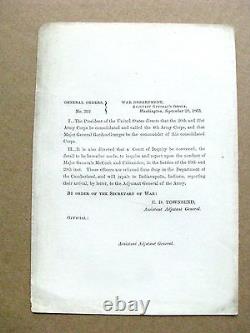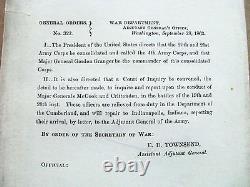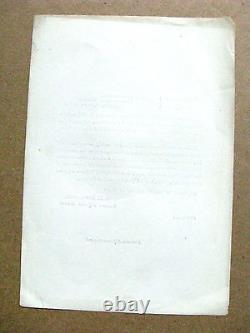
- Index
- Binding
- Conflict
- Region
- Subject
- Americana (17)
- Andrew Jackson (4)
- Civil War (42)
- Civil War, Men (6)
- Collectible (10)
- Family (3)
- Figures & Portraits (11)
- Historic & Vintage (3)
- History (60)
- Law & Government (3)
- Literature & Fiction (7)
- Men (9)
- Men, Civil War (89)
- Men, Military (28)
- Military (69)
- Military & Political (102)
- Military & War (179)
- Military, Political (6)
- Portrait (6)
- Presidents (5)
- ... (3435)
- Theme
- Americana (9)
- Antique (2)
- Army (3)
- Art (5)
- Celebrities (2)
- Civil War (10)
- Civil War General (2)
- Conflicts & Wars (7)
- Cosplay (2)
- History (10)
- Man, Portrait (2)
- Militaria (1098)
- Militaria, People (5)
- Militaria, Portrait (4)
- Military (2)
- Military & Adventure (13)
- Politics (6)
- Portrait (30)
- Portrait, Man (21)
- ... (2861)
- Year Printed
CIVIL War General Gordon Granger Command Order Crittenden & Mccook Courtmartial





Chickamauga was, after Gettysburg the most horrendous Battle of the Civil War, nearly equaling the latter in casualties and surpassing it in blunders due to the hostile terrain and poor visibility. As the 20th & 21st Army Corp collapsed after 2 days of very confused combat in unfamiliar terrain, many survivors and Corp Commanders General Edward McCook & Thomas Crittenden fled to Chattanooga, leaving General George Thomas, with the timely aid of General Gordon Granger to stand and prevent the destruction of the Army of the Cumberland. An original War Department 2 part General Order, issued at Washington, DC September 28, 1863- Part I giving General Granger command of the newly formed 4th Army Corp whose men redeemed their honor by leading the unordered assault on Missionary Ridge, Chattanooga. Granger is also remembered for his order issued at Galveston, Texas, June 19, 1865 announcing the Emancipation Proclamation, the origin of the Juneteenth Holiday & Part II relieving McCook & Crittenden of command, issued just a week after the Battle.
(Fellow commanders had long recognized that the latter two generals were drunkards, even by the standards of the time, that Alexander McCook was "a chucklehead" and that Thomas Crittenden had "just enough sense to keep still and do little"). 1p 8 x 5 ptd. Small archival repair on reverse edge, edge wear, age spots, Overall VG.
General & Special Orders were issued to communicate commands and information to the Army. Each order, issued in writing by a command, was then printed for distribution to each unit, either at an army department headquarter or by commanders at local headquarters, sometimes in the field on portable printing presses.The orders were then issued to regiments, often to be read aloud to the troops. General Orders were printed as issued with date & location; at the end of a year the regimental adjutant might retain them loose or simply string bind them by punching holes and stringing on ¼" red cloth string tape (the source of the old expression "government red tape). Sometimes an officer or HQ clerk might take a group of orders to a local print shop or bookbinder and have an accumulation bound with leather or cloth covers.
Usually, American Military Orders of the 19. Century including Civil War era were printed on an 8 x 5 sheet of quality rag paper.
General Orders and other imprints. All items are unconditionally guaranteed to be authentic and in the condition as described. PLEASE READ DETAILS OF THE ITEM DESCRIPTION. I TRY TO DESCRIBE ALL ITEMS ACCURATELY.
